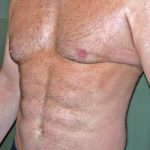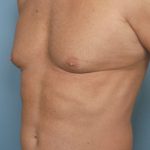Abdominal etching is a specialized liposuction procedure used to enhance the appearance of the abdomen. It is a sculpting advancement over flattening of the abdomen alone with liposuction. The procedure has been historically used in athletic males and is generally associated with a fairly high success rate with few complications.
But abdominal etching is not always predictable for everyone and poor results do occur. The most common problems include inconsistent etching lines and lines that are unnatural or are not in line with the inscription patterns of the underlying abdominal muscles. Inconsistent lines can be improved by revisional surgery. Incorrect line placement is difficult to correct.

Proper and accurate marking of the etched lines before surgery is done from multiple positions. Standing, sitting and tightening the abdominal muscles are all used to find the natural location of the muscle edges and the inscriptions. Any horizontal skin creases are helpful but they do not always coincide with the inscription levels. There is no pre-existing outline pattern or specific measurements for the location of the etch lines. Each patient is unique and is rarely perfectly symmetric.
From an abdominal contouring standpoint, etching can be done alone or part of an overall abdominal liposuction procedure. In general, the results are not surprisingly better when etch lines are put in alone. But most male patients need a combination of etch lines and liposuction between the etch lines to get their desired result. When done together, general abdominal flattening is done first. Etching should always start in the midline going up from the inside of the umbilicus with a long cannula. Then through horizontal stab incisions from the midline, the horizontal lines are put in with a bidirectional approach. No more than three horizontal lines are needed. Additional vertical lines may be put in near the outer edge of the rectus muscle but this is optional. It is important to not overdo the number of lines which can create an unnatural look. The use or deletion of these lines should be reviewed with the patient beforehand for their input. Most of the time I do not do them unless specifically requested.
Smart abdominal etching means that it is done with the use of the laser probe. The use of heat to create the lines does work but it is important to not run the laser probe directly on the underside of the skin. This may cause skin burns with ‘end hits’ while doing the horizontal lines and may cause the lines to develop some temporary thickening or hypertrophy.
Dr. Barry Eppley
Indianapolis, Indiana



